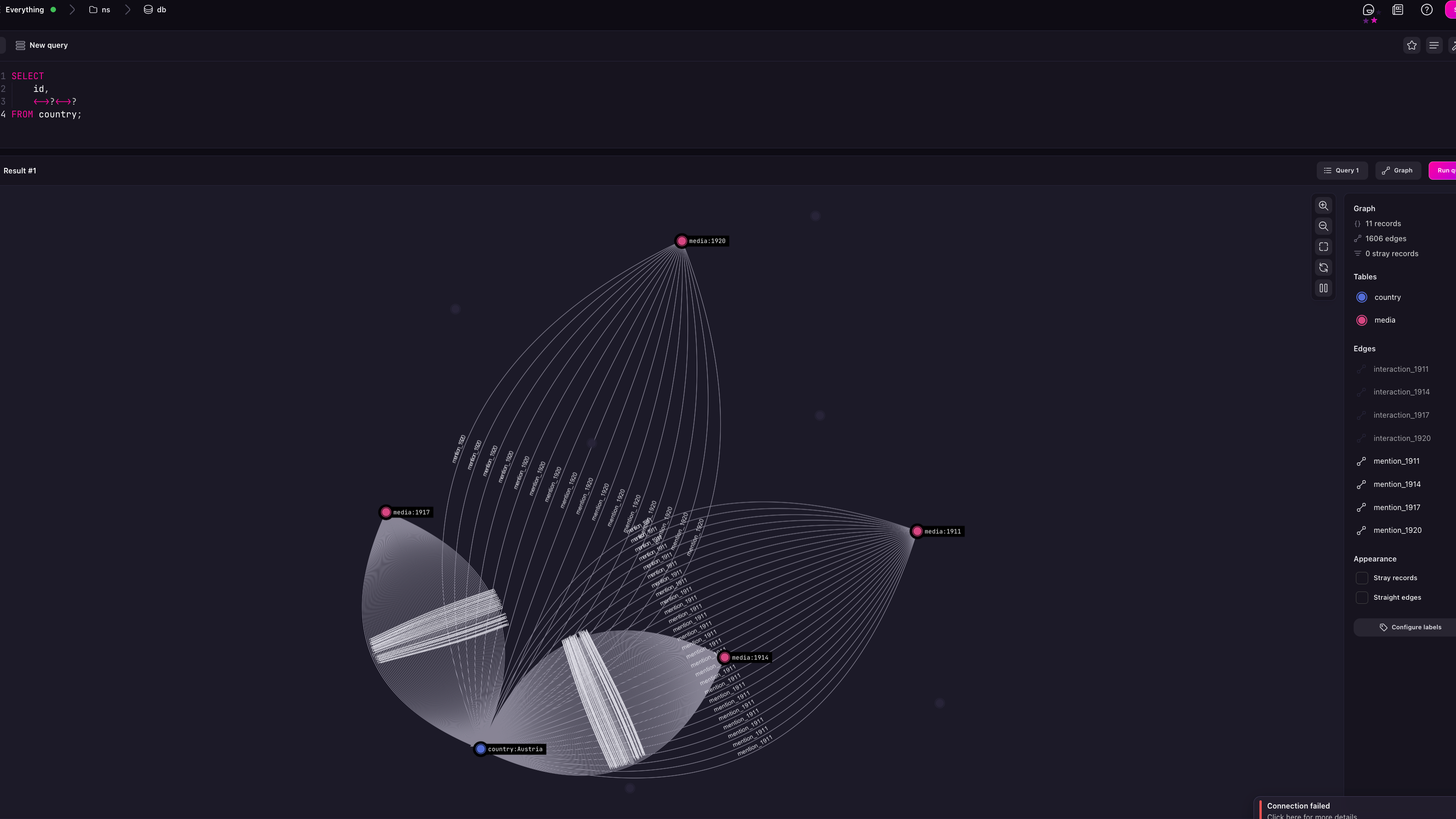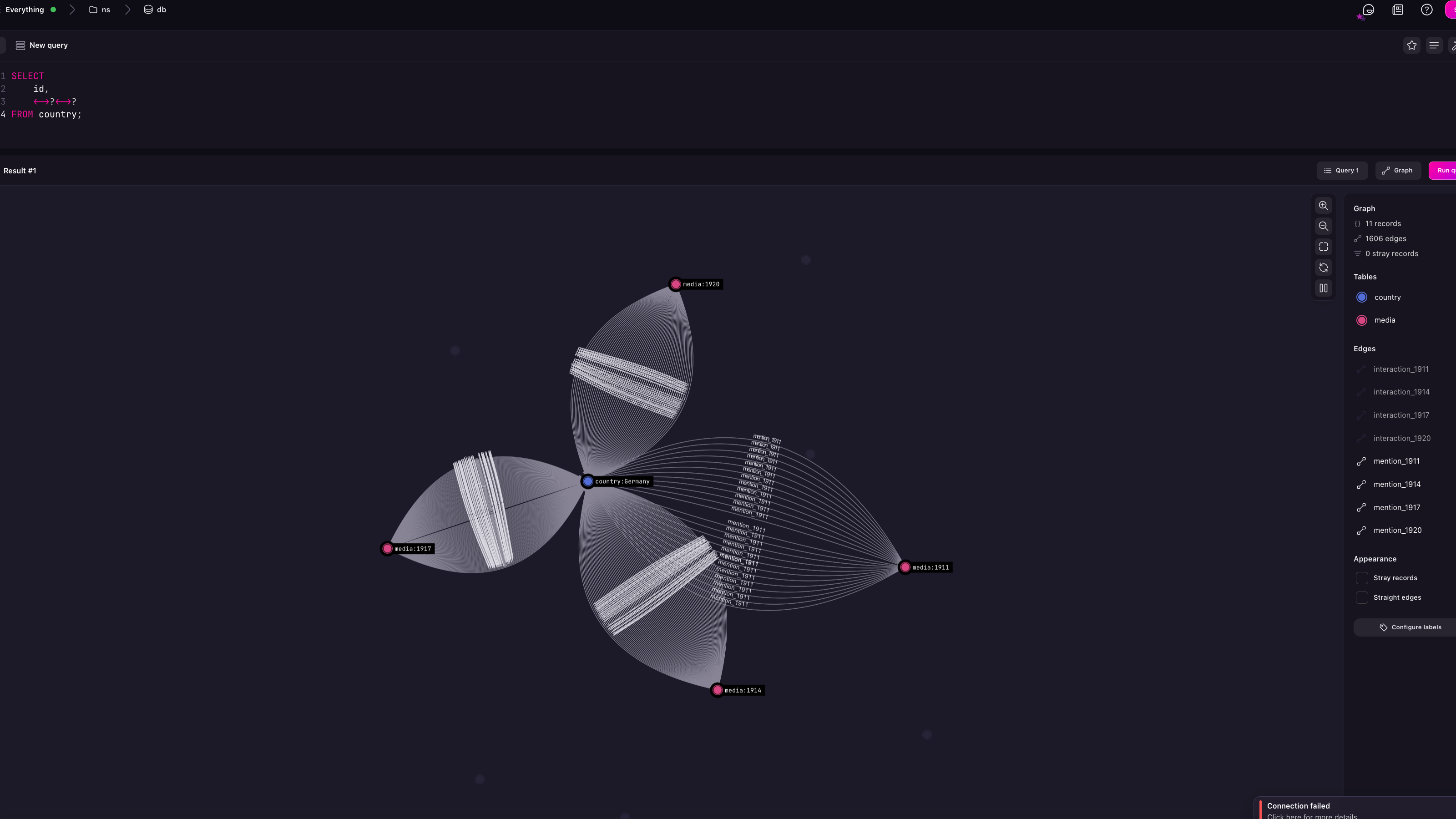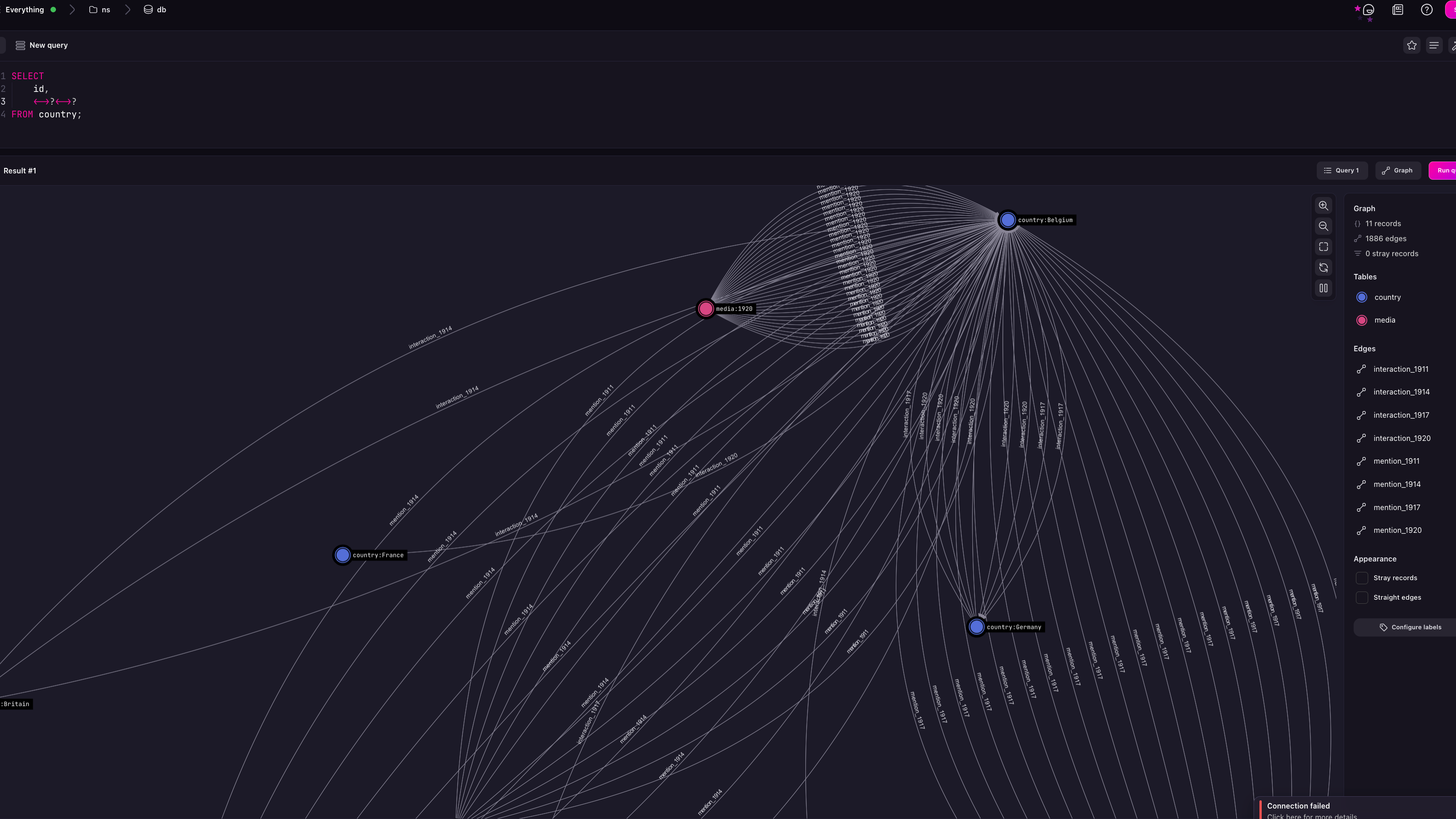Using historical books to create structured knowledge graphs in SurrealDB
Show all postsq(80)/d30oumjg6hac739vbqh0.auto)
Subscribe to the newsletter
Explore our releases, news, events, and much more
Welcome back to the second blog post on giving structure to unstructured data so that it can be stored and worked with in SurrealDB. If you haven’t seen the first post yet, check it out here.
While the original content of that first post had no structure, it was still fairly predictable and involved working with quick self-introductions of this sort that made it easy to work with:
“My name is Tyler Banks, and I’ve been working as a software engineer for the past four years. Currently, I’m part of the developer relations team, where I focus on creating tools and documentation to help developers integrate our APIs more easily. Our team is led by Brian Thompson.”
This time we are going to work with some content that is much less predictable. We are going to get into the mind of a historical researcher who wants get an idea of how the First World War changed the views of the English-speaking world towards certain nations in Europe. The shift from the largely peaceful Belle Époque into a worldwide war was such a sudden transition that it remains one of the most researched parts of world history.
A researcher studying this could structure the project in three-year intervals like this:
- How did people feel in 1911, three years before the war began?
- How did people feel in 1914 during and after the leadup to the war?
- How did people feel in 1917 when the entire continent had been at war for years?
- How did people feel in 1920 after it was over?
A researcher doing this would ideally go through thousands and thousands of books, newspaper articles, and anything else available. We don’t have the space for that in this blog post. Instead, we will choose one book from each year that pertains to Europe as a whole in as general a way as possible.
Archive.org is the best place to find books from the past that can be read online and downloaded as pdfs, and a quick search is enough to find some good candidate books.
The four books are:
- The Complete Pocket-Guide to Europe, written in 1911 during happier times in Europe. 592 pages.
- Europe Since Napoleon, written in 1914. It includes recent events at the time such as those in the Balkan Peninsula. 368 pages.
- Present-day Europe: Its National States of Mind, written in 1917. 346 pages.
- Geographical and Industrial Studies: The New Europe, written in 1920. 474 pages.
Starting the project and checking the data
To get started, use cargo new history
to start a new project, then download the pdfs for each book and save them as 1911.pdf, 1914.pdf, 1917.pdf, and 1920.pdf. Here are the pdf links.
A little bit of code using the pdf_extract
crate is enough to turn these pdfs into .txt
files.
Note: If you don’t feel like following this step, just click on the FULL TEXT
button inside each book’s page on Archive.org where the text has already been extracted. But since we are following the steps of an imaginary researcher who may be working with random pdfs from all sorts of sources, knowing how to extract the text from a pdf is a good place to start.
In the last post we only used the QuestionAnsweringModel from the rust_bert
crate, but there are many other models to choose from. The first model to try out is the SentimentModel. This model gives outputs that look like this, and is a very confident one with scores that are very often in the high 0.9s. The polarity
part of the output is a simple enum that only has two variants: Positive
and Negative
.
This model will be a good way to give our books a quick test to see if they do have enough content, and whether our hypothesis is correct that sentiment should change drastically from year to year.
The code below first creates the model, then goes through the books line by line to see if a country’s name shows up. If so, it will check the sentiment and keep it if the confidence level is at least 0.9. Finally, it adds up the number of positive and negative results and displays them per country per year.
Looks like the model is working well and these four books have good data. We can see Germany’s positive ratio drop in 1914, plummet in 1917, and recover after the war. Britain is pretty much stable throughout, France drops a little bit in 1914, and Russia had a catastrophic drop in 1914 after which its ratio recovered.
Adding a second model
The SentimentModel
works well enough to get a general sentiment of how a country is portrayed. But we’d also like to find the interactions that took place between one country or another in each of these books. Now, keep in mind that while each of these books are written in a certain year, they include events from well before that year. So for example, the book written in 1917 is not a book about the year 1917, but a book about Europe written by an author who views the continent from a 1917 point of view.
To give this a try, we can use the ZeroShotClassificationModel we mentioned in the last post but never tried. This model requires some fine tuning but is quite fun to use.
The Zero-shot classification model takes a number of options that it then compares against a text and then returns a confidence level for each. For example, if you took the text of this blog and gave it the options [“tech blog”, “grocery list”, “comic book”], it would have a high confidence for the first option and next to zero for the other two.
It’s quite good when the source text possible options are clear. Here’s a clear example from the book written in 1920:
Germany planned to march her armies quickly through Belgium into France and take Paris.
Since we are considering which countries have positive or negative reactions to each other, we would like to somehow know that this is a negative event between Germany and France. We can test it out by seeing whether it thinks “Germany did something good to France” is more plausible, or whether “Germany did something good to France” is. The 1024 in the code below represents the tokens used for the ZeroShotClassificationModel
’s default model.
Printing out the text
and score
fields shows that it did a pretty good job. Though note that this model tends to be not very confident: only 0.76. You need a text like “Germany invaded France” for it to reach 0.99.
However, the vast majority of the content in these books will have nothing to do with one country or another. So we’ll want a third variant that represents a “none of the above” situation. Coming up with this third variant is the tricky part. Let’s see what happens when we try a “{country_one} did nothing in particular to {country_two}” format, such as “Germany did nothing in particular to France”. We’ll also include a statement after the first one that has nothing to do with either Germany or France: “I dedicate this book to my cat”.
The model still does a good job with the first sentence, but not at all with the second. For the second, it is not at all convinced about any of the three options but still has a slight preference for “Germany did something bad to France” for the sentence “I dedicate this book to my cat”.
The same sort of output happens if we try “Nothing happened”. The model seems quite sure that at least something did happen.
Things look better if we change this to “Something else happened”. This variant gets a certain amount of confidence, but not enough to overshadow something like “Germany did something bad to France” if the model is very sure about that statement.
If you are feeling ambitious at this point, you could bring in the QuestionAnsweringModel
that we used in the last post to do a second check to confirm that something happened between one country and another.
This would let you check the score
again and throw out anything with a low level of confidence, as well as grab the answer
for a quicker textual representation than the full line of context.
We won’t be using this model in addition to the other two due to lack of time and space, but feel free to give it a try!
The rest of the code
The rest of the code involves working with these two models to create two types of graph relations: a media->mention->country
path and a country->interaction->country
path. For media
we will create records like media:1911
for each year, which will make the graphical summary at the end more interesting to work with. And the countries we will look at will each have their own record.
CREATE media:1911, media:1914, media:1917, media:1920, country:Germany, country:France, country:Russia, country:Belgium, country:Italy, country:Austria, country:Britain;
Each of these edges can be inserted using a Rust struct that holds some information on the records involved and the context. (We could use a Datetime
for the year but we’ll go with a String
for simplicity)
Next is a function to break each book into chunks. It’s a simple function that just grabs 400 characters, turns new lines into spaces, and removes the large spaces you sometimes see between words generated from pdfs, like “Ge- rmany”.
After that comes all the logic to work with the models for each possible combination of country for each book. To speed up the models we have batched the inputs to a certain extent. However, we haven’t collected absolutely everything before batching because the database can insert these graph edges at each combination of year and country, and that will let us go straight to Surrealist to begin taking a look at the results even as they are coming in. To ensure that we know what’s going on we have a println!
statement at each point in the way.
Here is all the code:
Querying the results
If you start a new SurrealDB instance via the surreal start --unauthenticated
command and then run this code with cargo run
(preferably cargo run --release
for greater performance as there is a lot of data to work with), you should see this sort of output in the terminal. It will take some time to get through all of the content in each of the books.
But we can start looking at the data right away as it comes in. As it runs, go to Surrealist and connect. Let’s see what we can see with some queries.
Here’s one to show a single negative example of one thing a country did, followed by one thing a country had done to it over a single year.
Sometimes the individual results show passages that truly do reflect interactions between two countries, such as these two between Austria and Germany.
But sometimes the passage only holds a more general sentiment that isn’t perfectly accurate. In the first example here we see a “negative interaction” between Italy and France that in fact is just an Italian politician making a negative speech along with a previous sentence showing France declaring war.
But keep in mind that the use case here is a researcher using thousands and thousands of books and articles to gauge general sentiment. That means that we would probably see queries more in this sort of way
This is especially the case if we remember that a real researcher would have thousands and thousands of books and articles to work with, all with different lengths and styles of writing.
That will show much more general trends for each country, such as this which shows Italy’s interactions with Britain over the years.
Or the total positive and negative numbers for each country over the years, which now differs from our original test because this time we are working with 400-character chunks instead of single lines.
The results for Germany are still similar to our original test, just fewer in number.
Finally, there are visual queries that we can do with Surrealist’s graph visualization view. These have been saved for last because they are by far the most fun.
If you want some examples on how to use this view in general, see this blog post.
To start off, we can use this query that looks at both the in
and out
fields of any graph edges connected to a country to see the entire network of edges we have. There are 1886 edges in total, making it a pretty noisy graph.
Since we’ve chosen a lot of edge names, we actually don’t need to use any other queries to start poking through the data. Instead, we can select and deselect the edges on the right of the screen and mouseover the parts we are most interested in. If we only show the mentions for a country, we can see some general trends such as how Austria fades out as a subject of mention in 1920:

But not so for Germany, which is still heavily mentioned.

You can also see when choosing to display all edges that Belgium is mentioned quite a bit in 1920 compared to the other books.

Finding interesting bits to then check out with a more comprehensive query is exactly what this view is for. Let’s put a query together to calculate the mentions per year per country to see if Belgium really is mentioned more in 1920 than the other countries.
And it turns out that this is the case! Belgium is mentioned in the 1920 book way more than in previous years, while Austria at the bottom has completely dropped off the map. We can’t draw any conclusions from this single book, but it might be a hint that the world in 1920 was particularly interested in Belgium’s reconstruction. Only more data will tell.
q(50)/d2rj87bg6hac739vbks0.auto)
q(50)/d39dq1tq0ptc73ba3d9g.auto)